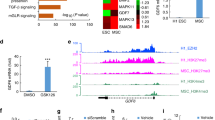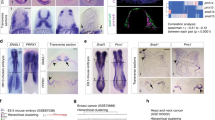Abstract
The Snail1 transcriptional repressor plays a key role in triggering epithelial-to-mesenchymal transition. Although Snail1 is widely expressed in early development, in adult animals it is limited to a subset of mesenchymal cells where it has a largely unknown function. Using a mouse model with inducible depletion of Snail1, here we demonstrate that Snail1 is required to maintain mesenchymal stem cells (MSCs). This effect is associated to the responsiveness to transforming growth factor (TGF)-β1 that shows a strong Snail1 dependence. Snail1 depletion in conditional knockout adult animals causes a significant decrease in the number of bone marrow-derived MSCs. In culture, Snail1-deficient MSCs prematurely differentiate to osteoblasts or adipocytes and, in contrast to controls, are resistant to the TGF-β1-induced differentiation block. These results demonstrate a new role for Snail1 in TGF-β response and MSC maintenance.
This is a preview of subscription content, access via your institution
Access options
Subscribe to this journal
Receive 50 print issues and online access
$259.00 per year
only $5.18 per issue
Buy this article
- Purchase on Springer Link
- Instant access to full article PDF
Prices may be subject to local taxes which are calculated during checkout







Similar content being viewed by others
References
Peinado H, Olmeda D, Snail Cano A. . ZEB and bHLH factors in tumour progression: and alliance against the epithelial phenotype? Nat Rev Cancer 2007; 7: 415–428.
Garcia de Herreros A, Peiro S, Nassour M, Savagner P . Snail family regulation and epithelial-mesenchymal transitions in breast cancer progression. J Mammary Gland Biol Neoplasia 2010; 15: 135–147.
Batlle E, Sancho E, Francí C, Domínguez D, Monfar M, Baulida J et al. The transcription factor snail is a repressor of E-cadherin gene expression in epithelial tumour cells. Nat Cell Biol 2000; 2: 84–89.
Cano A, Pérez-Moreno MA, Rodrigo I, Locascio A, Blanco MJ, del Barrio MG et al. The transcription factor snail controls epithelial-mesenchymal transitions by repressing E-cadherin expression. Nat Cell Biol 2000; 2: 76–83.
Solanas G, Porta-de-la-Riva M, Agustí C, Casagolda D, Sánchez-Aguilera F, Larriba MJ et al. E-cadherin controls beta-catenin and NF-kappaB transcriptional activity in mesenchymal gene expression. J Cell Sci 2008; 121: 2224–2234.
Stanisavljevic J, Porta-de-la-Riva M, Batlle R, García de Herreros A, Baulida J . The p65 subunit of NF-kB and PARP1 assist Snail1 in activating Fibronectin transcription. J. Cell Sci 2011; 124: 4161–4171.
Carver EA, Jiang R, Lan Y, Oram KF, Gridley T . The mouse snail gene encodes a key regulator of the epithelial-mesenchymal transition. Mol Cell Biol 2001; 21: 8184–8188.
Murray SA, Gridley T . Snail family genes are required for left-right asymmetry determination, but not neural crest formation, in mice. Proc Natl Acad Sci USA 2006; 103: 10300–10304.
Francí C, Takkunen M, Dave N, Alameda F, Gómez S, Rodríguez R et al. Expression of Snail protein in tumor-stroma interface. Oncogene 2006; 25: 5134–5144.
Francí C, Gallén M, Alameda F, Baró T, Iglesias M, Virtanen I et al. Snail1 protein in the stroma as a new putative prognosis marker for colon tumours. PLoS One 2009; 4: e5595.
Vincent T, Neve EP, Johnson JR, Kukalev A, Rojo F, Albanell J et al. A SNAIL1-SMAD3/4 transcriptional repressor complex promotes TGF-β mediated epithelial-mesenchymal transition. Nat Cell Biol 2009; 11: 943–950.
Rowe RG, Li XY, Hu Y, Saunders TL, Virtanen I, Garcia de Herreros A et al. Mesenchymal cells reactivate Snail1 expression to drive three-dimensional invasion programs. J Cell Biol 2009; 184: 399–408.
Peinado H, Quintanilla M, Cano A . Transforming growth factor TGF-b1 induces Snail transcription factor in epithelial cell lines. J Biol Chem 2003; 278: 21113–21123.
Ignotz RA, Massague J . Type beta transforming growth factor controls the adipogenic differentiation of 3T3 fibroblasts. Proc Natl Acad Sci USA 1985; 82: 8530–8534.
Pittenger MF, Mackay AM, Beck SC, Jaiswal RK, Douglas R, Mosca JD et al. Multilineage potential of adult human mesenchymal stem cells. Science 1999; 284: 143–147.
DaCosta Byfeled S, Major C, Laping NJ, Roberts AB . SB-505124 is a selective inhibitor of transforming growth factor-beta I type I receptors ALK4, ALK5 and ALK7. Mol Pharmacol 2004; 65: 744–752.
Sawyer JS, Anderson BD, Beight DW, Campbell RM, Jones ML, Herron DK et al. Synthesis and activity of new aryl- and heteroaryl-substituted pyrazole inhibitors of the transforming growth factor-beta type I receptor kinase domain. J Med Chem 2003; 46: 3953–3956.
Ryu JM, Lee MY, Yun SP, Han HJ . High glucose regulates cyclin D1/E of human mesenhcymal stem cells through TGF-β1 expression via Ca2+/PKC/MAPKs and PI3K/Akt/mTOR signal pathways. J Cell Physiol 2010; 224: 59–70.
Escrivà M, Peiró S, Herranz N, Villagrasa P, Dave N, Montserrat-Sentís B et al. Repression of PTEN phosphatase by Snail1 transcriptional factor during gamma radiation-induced apoptosis. Mol Cell Biol 2008; 28: 1528–1540.
Dezawa M, Ishikawa H, Itokazu Y, Yoshihara T, Hoshino M, Takeda S et al. Bone marrow stromal cells generate muscle cells and repair muscle degeneration. Science 2005; 309: 314–317.
de Frutos CA, Vega S, Manzanares M, Flores JM, Huertas H, Martínez-Frías ML et al. Snail1 is a transcriptional effector of FGF3 signaling during chondrogenesis and achondroplasias. Dev Cell 2007; 13: 872–883.
de Frutos CA, Dacquin R, Vega S, Jurdic P, Machuca-Gayet I, Nieto MA . Snail1 controls bone mass by regulating Runx2 and VDR expression during osteoblast differentiation. EMBO J 2009; 28: 686–696.
Pérez-Mancera PA, Bermejo-Rodríguez C, González-Herrero I, Herranz M, Flores T, Jiménez R et al. Adipose tissue mass is modulated by SLUG (SNAI2). Hum Mol Genet 2007; 16: 2972–2986.
Peiró S, Escrivà M, Puig I, Barberà MJ, Dave N, Herranz N et al. Snail1 transcriptional repressor binds its own promoter and controls its expression. Nucl Acids Res 2006; 34: 2077–2084.
Runyan CE, Schnaper HW, Poncelet AC . The phosphatidylinositol 3-kinase/Akt pathway enhances Smad3-stimulated mesangial cell collagen I expression in response to transforming growth factor-b1. J Biol Chem 2004; 279: 2632–2639.
Ghosh Choudhury G, Abboud HE . Tyrosine phosphorylation-dependent PI3 Kinase/Akt signal transduction regulates TGF-β-induced fibronectin expression in mesangial cells. Cell Signal 2004; 16: 31–41.
Yi JY, Shin I, Arteaga CL . Type I transforming growth factor b receptor binds to and activates phosphatidylinositol 3-kinase. J Biol Chem 2005; 280: 10870–10876.
Vega S, Morales AV, Ocaña OH, Valdés F, Fabregat I, Nieto MA . Snail blocks the cell cycle and confers resistance to cell death. Genes Dev 2004; 18: 1131–1143.
Villagrasa P, Díaz VM, Viñas-Castells R, Peiró S, Del Valle-Pérez B, Dave N et al. Akt2 interacts with Snail1 in the E-cadherin promoter. Oncogene 2011; 31: 4064–4075.
Hill R, Wu H . PTEN, stem cells and cancer stem cells. J Biol Chem 2009; 284: 11755–11759.
Wu X, Chen S, Orlando SA, Yuan J, Kim ET, Munugalavadla V et al. p85α regulates osteoblast differentiation by cross-talking with the MAPK pathway. J Biol Chem 2011; 286: 13512–13521.
Irie HY, Pearline RV, Grueneberg D, Hsia M, Ravichandran P, Kothari N et al. Distinct roles of Akt1 and Akt2 in regulating cell migration and epithelial-mesenchymal transition. J Cell Biol 2005; 171: 1023–1034.
Mukherjee A, Rotwein P . Selective signaling by Akt1 controls osteoblast differentiation and osteoblast-mediated osteoclast development. Mol Cell Biol 2012; 32: 490–500.
Murray SA, Carver EA, Gridley T . Generation of a Snail1 (Snai1) conditional null allele. Genesis 2006; 44: 7–11.
Soleimani M, Nadri S . A protocol for isolation and culture of mesenchymal stem cells from mouse bone marrow. Nat Protoc 2009; 4: 102–106.
Bellacosa A, Chan TO, Ahmed NN, Datta K, Malstrom S, Stokoe D et al. Akt activation by growth factors is a multi-step process: the role of the PH domain. Oncogene 1998; 17: 313–325.
Acknowledgements
We thank M Massoumi for help in the preparation of MSCs, Td’Altri for assistance in the FACS analysis, N García-Giralt and L Larue for reagents, L diCroce for comments and E Batlle for support and advice. This study was funded by a grant awarded by la Fundación Científica de la Asociación Española contra el Cáncer to AGH, JIC and FB. Support from the Ministerio de Ciencia y Tecnología (SAF2006-00339 and SAF2010-16089) and Fundació La Marató de TV3 to AGH, and NIH R01HD034883 to TG is also appreciated. We also acknowledge support from ISCIII/FEDER (RD06/0020/0109, RD06/0020/0040, RD06/0020/0020), Generalitat de Catalunya (2009SGR867). RB and LA-C were recipients from FPI predoctoral fellowships.
Author information
Authors and Affiliations
Corresponding author
Ethics declarations
Competing interests
The authors declare no conflict of interest.
Additional information
Supplementary Information accompanies the paper on the Oncogene website
Supplementary information
Rights and permissions
About this article
Cite this article
Batlle, R., Alba-Castellón, L., Loubat-Casanovas, J. et al. Snail1 controls TGF-β responsiveness and differentiation of mesenchymal stem cells. Oncogene 32, 3381–3389 (2013). https://doi.org/10.1038/onc.2012.342
Received:
Revised:
Accepted:
Published:
Issue Date:
DOI: https://doi.org/10.1038/onc.2012.342
Keywords
This article is cited by
-
Dynamic alterations in metabolomics and transcriptomics associated with intestinal fibrosis in a 2,4,6-trinitrobenzene sulfonic acid-induced murine model
Journal of Translational Medicine (2023)
-
LINC01013 Is a Determinant of Fibroblast Activation and Encodes a Novel Fibroblast-Activating Micropeptide
Journal of Cardiovascular Translational Research (2023)
-
Formation of an invasion-permissive matrix requires TGFβ/SNAIL1-regulated alternative splicing of fibronectin
Breast Cancer Research (2023)
-
Loss of SNAI1 induces cellular plasticity in invasive triple-negative breast cancer cells
Cell Death & Disease (2022)
-
Effects of high glucose conditions on the expansion and differentiation capabilities of mesenchymal stromal cells derived from rat endosteal niche
BMC Molecular and Cell Biology (2019)



